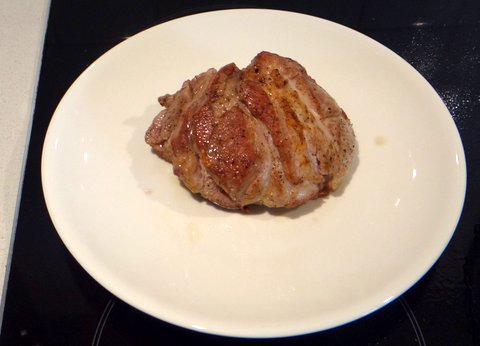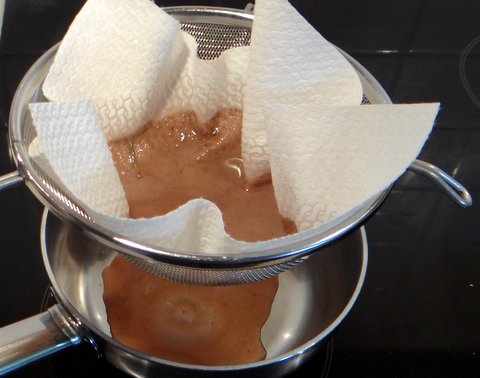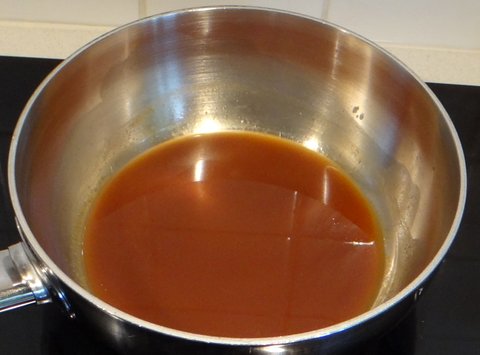Lamb shoulder is really good if it’s slow cooked, so sous-vide is the obvious way to cook this cut of lamb. The meat will be amazingly tender and juicy. When slow-cooking lamb, make sure it’s from an ewe (female lamb). Rams (male lambs) have a strong smell that will be accentuated by long cooking. At Librije I discovered how good lamb and goat cheese are together. If you don’t have sous-vide equipment, roast a leg of lamb in the oven and serve it with some pieces of good French raw-milk goat cheese at room temperature (don’t let it melt) and a nice red burgundy, red sancerre or other light pinot noir. You’ll be amazed!
Ingredients
For 2 servings
300 grams (2/3 pound) lamb shoulder (ewe/female)
1 Tbsp fresh rosemary needles
salt and freshly ground black pepper
4 Tbsp concentrated lamb stock
1 glass of red wine, preferably pinot noir
50 grams (2 oz) raw-milk aged goat cheese, such as Crottin de Chavignol or Chevre d’Or
olive oil
Preparation
Rub the lamb with salt and freshly ground black pepper. Brown the meat on all sides in a hot frying pan in some olive oil.
Vacuum seal the meat in a pouch with the rosemary.
After vacuum sealing, scald in hot water (80C/180F or boiling) for 10-20 seconds (click here to read why).
Cook for 24 hours at 57C/135F. I was using a young lamb, for an older lamb cook 48 hours instead of 24.
Take the meat out of the pouch, reserving the juices. Pat dry with paper towels and brown in a hot frying pan in olive oil.
Let the meat rest, covered with aluminum foil.
Meanwhile, deglaze the pan with the red wine.
Add the juices from the pouch.
The juices will curdle. Strain through a paper towel.
Add concentrated lamb stock and reduce over medium heat to obtain nice lamb juice.
Slice the meat and serve it on warm plates with pieces of goat cheese.
Wine pairing
Although goat cheese is usually paired with sauvignon blanc, the combination of lamb and goat cheese pairs excellently with a fresh pinot noir such as a red burgundy or red sancerre.














Stefan, three things:
1. Your recipes are getting better and better.
2. Your photography is getting better and better.
3. The pairing of goats cheese and lamb is inspired. I wil be trying it in France next week.
Best,
Conor
LikeLike
Thanks so much, Conor!
Have a great time in France — bon voyage!
LikeLike
Looks great- we will try this in the sous-vide…
LikeLike
Great, would love to hear how it turns out.
LikeLike
No such thing as female/male lamb……and as a lamb you couldn’t tell the difference. Male sheep that are not being kept as breeders are cut and end up as wethers I also query why you brown twice?
Like your stuff!!
LikeLike
Hi Keith, thanks for taking the time to comment.
In the Netherlands both female (ewe) and male (ram) lamb are being kept and slaughtered for meat. The male ones are not cut, because they are slaughtered at such a young age (about 4 months) that in traditional preparations the male scent is not an issue (male pigs kept for meat are cut for that very reason). However with 24-hour or longer sous-vide preparations the faint scent that is in fact present in the male lamb is amplified and becomes too strong. Even in female lamb quite a strong scent can develop, and I’ve found that it helps to brown twice. Browning before sous-vide provides additional flavor, because the browning flavors can penetrate into meat during the sous-vide cooking. Browning after sous-vide not only provides more browning flavor and texture (crispness), but also heats up the meat on the outside so it won’t get cold as quickly.
LikeLike
Hi Stefan
Good answers, I take those onboard,I guess we eat so much lamb here we are used to the strong flavours. my new unfinished site is sousvidenews.com Please take a look
LikeLike
Hi Keith, in the meantime I have found some info on beef with a similar smell that seems to be due to some kind of bacteria. I’m touring Australia at the moment, but will get back when I’m home and will also check out your site.
LikeLike
I love your suggestions of a red Sancerre – the best of both red and white worlds – to accompany the lamb and chèvre. I love the variety of chèvre you used, with the aged exterior and that it is unpasteurized, turning from creamy to soft and you move towards the center of the rind. Here, Delice or Remeux de Bourgogn are more available but not as flavorful – I love unpasteurized cheeses. Thank you for including instructions for those of us who don’t have sou-vuis. Do you think it would be okay if I added a bit of garlic? And how does one make lamb stock / what are the substitutions if not available? Lovely post, as always. I’m hungry now. Lamb is my favorite meat – and what a beautiful cut you used!
LikeLike
A bit of garlic is okay if it’s not too much and not brown but only lightly sauteed (otherwise it’ll turn bitter).
How to make lamb stock? Look here: https://stefangourmet.com/2012/12/02/lamb-stock/
You could substitute with beef stock, but the lamb has its own taste and smell that is hard to substitute. It might actually too ‘lamby’ for some. As lamb is your favorite meat, I’m sure you’ll love the smell of the lamb stock.
LikeLike
Oh, one can never have too much lamb flavor! Thanks for the link – the recipe looks straightforward and flavorful. Good point about the garlic… I had not thought of the ramifications of adding garlic!
LikeLike
HI I would like to sous vide lamb shank and lamb shoulder at the same time. what temp do you suggest?
LikeLike
Hi, best results are 57C/135F for the shoulder (24-48 hrs) and 62C/144F for the shank (48 hrs). If you have the time, my suggestion would be to cook the shank first for 48 hrs at 62C/144F, then chill the bag in ice water and refrigerate. Next cook the shoulder at 57C/135F for 24 hours (48 hours if it is from an older animal) and then reheat the shank alongside the shoulder for 3 hours or so.
If you do not have the time to do this, the alternative is to cook both at 62C/144F, first the shank for 24 hours and then add the shoulder and cook for another 24 hours together. The shoulder will be good, but not as good as when cooked at 57C/135F; it will be a bit dry. Hope this helps.
LikeLike
Thank you so much!
LikeLiked by 1 person